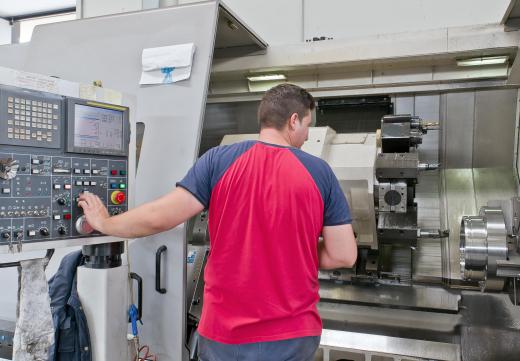Angle plates are metal supports used to hold other metal parts for precision machining operations. Often built from steel or aluminum, angle plates are designed with very flat surfaces and specific sizes needed to hold metal stock. Careful preparation of these plates is needed so that the final products have consistent dimensions or placement of holes.
Precision machining often uses computer numerical control (CNC) machines, which take computer-aided design (CAD) information and create a series of instructions for machining a part. CNC machines typically have a moving head that contains a variety of machine tools, including cutters, drills and grinders. These tools are activated by the computer instructions, and provide a series of cutting or drilling operations that create a finished item.

Some parts need to be fabricated in a vertical position, rather than laying horizontally on a flat surface. The CNC machine can follow a specific series of instructions, but it normally cannot correct for raw materials that are not flat or are held at an incorrect angle. A requirement for a strong and stable surface led to the development of angle plates.
Manufacturers of angle plates often provide custom fabrication services to their customers. This permits plates to be designed for holding parts at unusual angles, or for creating large plate surfaces for oversized items. As the size of a metal angle plate gets larger, the weight increases as well, so manufacturers may install crane or lift fittings to allow them to be moved.
Along with supporting the weight of items, it is important for the angle plate to include ways to secure the part in place during machining. The plates may include grooves, holes or special channels called T-slots that permit clamps or braces to be slid into place. Customers can select generic angle plates, with channels placed at regular intervals, or can specify custom locking points for unusual shapes or sizes.
Angle plates vary widely in shape and size, but typically contain a flat plate that acts as a base. A vertical or angled surface with channels or holes to secure the part is welded to the base. Support plates, or gussets, are welded to the back of the vertical plate and the base to provide rigidity and support. The plates can be made from different metals, depending on the need for higher strength of steel or corrosion resistance and lighter weight of aluminum.
Items requiring holes to be drilled may be secured on angle plates with a similar hole pattern. As the CNC machine performs the drilling instructions, the holes prevent the drill bits from hitting the angle plate, reducing the chance of damage. This permits repeated drilling of precision holes in successive parts, guided by the computer programming in the CNC machine.
